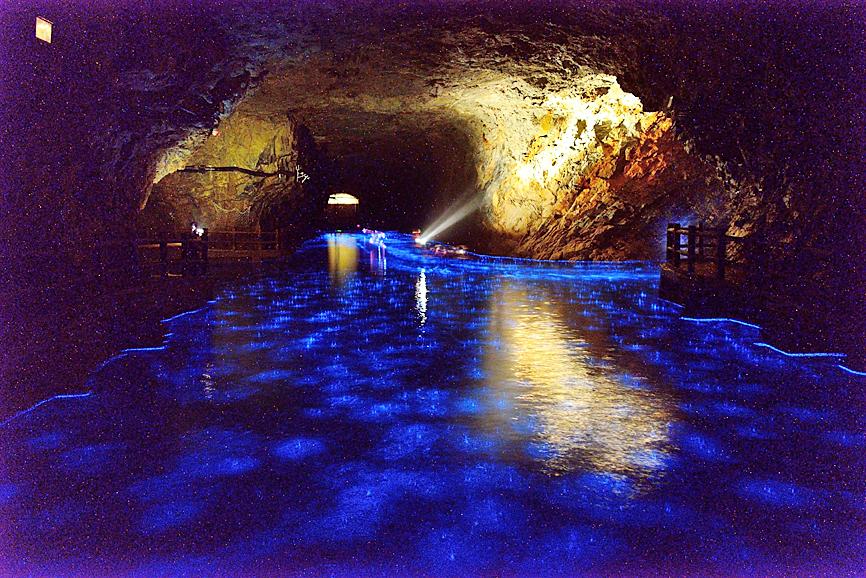The “blue tears” in Matsu County might be a result of environmental stresses affecting the reproductive cycle of the organisms that cause the phenomenon, a study in Frontiers in Marine Science authored by a research team at National Taiwan Ocean University said.
The blue luminescence in the sea near Matsu from April to August — known locally as “blue tears” — is a tourist attraction and has been listed by CNN as one of the top 15 natural scenic wonders of the world.
The blue tears result when sexual reproduction among Noctiluca scintillans, a bioluminescent red-tide algae, rapidly increases, National Taiwan Ocean University professor Chiang Kuo-ping (蔣國平) said on Friday.

Photo courtesy of Lienchiang County Government
The study sought to determine factors that prompt an uptick in sexual reproduction of the organisms, which usually reproduce asexually, and the ecological role in that change, Chiang said.
“Reproduction in N scintillans involves both sexual and asexual processes. The vegetative cell, or trophont cell, mostly undergoes binary fission, but randomly undergoes gametogenesis, which produces gametes that afterward fuse in pairs form zygotes,” the authors wrote, adding that gametogenesis — which enables sexual reproduction — might be triggered by environmental stresses, “including temperature, light exposure time, prey concentration, N scintillans concentration, cultivation time, cultivation volume and simulated wave motion.”
The reproduction cycle occurs annually, usually between March and July, with the arrival of sediment from the Min River (閩江) — which enters the Taiwan Strait near Fuzhou in China’s Fujian Province — resulting in red tides in the morning and the “blue tears” at night, Chiang said, adding that the phenomenon usually occurs for one or two days.
The critical value for N scintillans to reproduce sexually was found to be 35,400 prey cells for each N scintillans, indicating that the fewer prey cells there are after a certain amount of population growth, the more likely it is that N scintillans would reproduce sexually, he said.
The team found that after an exponential phase of population growth, the encounter rate with prey decreases, prompting an increase in the sexual reproduction rate from the usual 1 percent to as much as 10 percent of the population, Chiang said.
This results in the “blue tears” bloom and also lays the foundation for the next bloom period, he said.
The study, Sexual reproduction in dinoflagellates — the case of Noctiluca scintillans and its ecological implications, was authored by doctoral student Jeffery Lee (李良能), and coauthored by Chiang and assistant professor Tsai Sheng-fang (蔡昇芳).
It was published in the journal’s Nov. 17 edition.

Beijing could eventually see a full amphibious invasion of Taiwan as the only "prudent" way to bring about unification, the US Department of Defense said in a newly released annual report to Congress. The Pentagon's "Annual Report to Congress: Military and Security Developments Involving the People's Republic of China 2025," was in many ways similar to last year’s report but reorganized the analysis of the options China has to take over Taiwan. Generally, according to the report, Chinese leaders view the People's Liberation Army's (PLA) capabilities for a Taiwan campaign as improving, but they remain uncertain about its readiness to successfully seize

Taiwan is getting a day off on Christmas for the first time in 25 years. The change comes after opposition parties passed a law earlier this year to add or restore five public holidays, including Constitution Day, which falls on today, Dec. 25. The day marks the 1947 adoption of the constitution of the Republic of China, as the government in Taipei is formally known. Back then the Chinese Nationalist Party (KMT) governed China from Nanjing. When the KMT, now an opposition party in Taiwan, passed the legislation on holidays, it said that they would help “commemorate the history of national development.” That

Taiwan has overtaken South Korea this year in per capita income for the first time in 23 years, IMF data showed. Per capita income is a nation’s GDP divided by the total population, used to compare average wealth levels across countries. Taiwan also beat Japan this year on per capita income, after surpassing it for the first time last year, US magazine Newsweek reported yesterday. Across Asia, Taiwan ranked fourth for per capita income at US$37,827 this year due to sustained economic growth, the report said. In the top three spots were Singapore, Macau and Hong Kong, it said. South

Snow fell on Yushan (Jade Mountain, 玉山) yesterday morning as a continental cold air mass sent temperatures below freezing on Taiwan’s tallest peak, the Central Weather Administration (CWA) said. Snowflakes were seen on Yushan’s north peak from 6:28am to 6:38am, but they did not fully cover the ground and no accumulation was recorded, the CWA said. As of 7:42am, the lowest temperature recorded across Taiwan was minus-5.5°C at Yushan’s Fengkou observatory and minus-4.7°C at the Yushan observatory, CWA data showed. On Hehuanshan (合歡山) in Nantou County, a low of 1.3°C was recorded at 6:39pm, when ice pellets fell at Songsyue Lodge (松雪樓), a